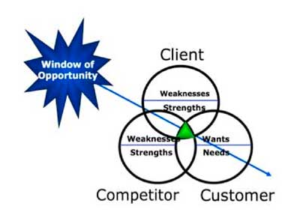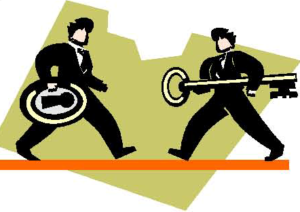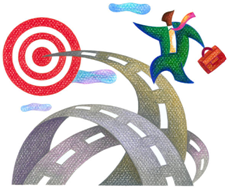Connected Managing by Personality Traits
By Dana & Ellen Borowka, excerpt from Cracking the Personality Code
“Watch your words: they become your thoughts.
Watch your thoughts: they become your actions.
Watch your actions: they become your habits.
Watch your habits: they become your destiny.”
∼ Frank Outlaw
Personality tests not only help when hiring, they just might be a manager’s best tool to connect with employees. You can manage the hard way or the easy way, the choice is up to you. The hard way is to be the “my way or the highway” type of boss. You know the kind, always forcing workers to do things in a  way that isn’t natural for them. Wouldn’t it be better to use your understanding of personality traits to tap into the natural flow so you can get the best out of your people? Of course, knowing your employees, understanding their concerns, and developing connected relationships with them should be the normal procedure for all managers.
way that isn’t natural for them. Wouldn’t it be better to use your understanding of personality traits to tap into the natural flow so you can get the best out of your people? Of course, knowing your employees, understanding their concerns, and developing connected relationships with them should be the normal procedure for all managers.
What is the payoff to a manager for developing connected relationships with employees using personality assessments? Here are three good benefits. First, it enables the manager to better anticipate what roadblocks might occur with a worker, and what to try to reduce this resistance. Second, understanding where employees are coming from will help you plan out how much participation you need from them and will give some clues as to how change should be communicated to them. Third, creating connected relationships builds commitment and loyalty.
Take the Connected Leader Test
How connected are you as a manager? To find out, we asked our colleague Dr. Bruce Heller, an industrial psychologist with twenty years experience and author of The Prodigal Executive–How to Coach Executives Too Painful to Keep, Too Valuable to Fire, to help us design a quick connected leader self-test. For each of the ten questions, choose the response that best matches your situation. Then give yourself the corresponding point value for each question. Total up your score and look to the end of the test for how to interpret your score.
Connected Leader Questions
Scoring instructions:
Don’t know = 1 point, Never = 2 points, Seldom = 3 points, Often = 4 points, Always = 5 points
1. Do you get personally involved with co-workers, colleagues, peers, and others?
2. Do you believe that your role as a leader is to serve your direct reports?
3. Do you feel your employees are motivated to help you achieve your goals?
4. How often do you acknowledge a special occasion of a direct report?
5. Do you reflect upon the potential impact you make on direct reports?
6. Do you spend time thinking about meeting the needs of others
7. Do you consider yourself a sensitive leader?
8. In your family, did your parents spend time listening and reflecting on an emotional level?
9. Do you think your peers and direct reports consider you a sensitive leader?
10. Do you keep a journal of your interactions and conversations?
Your Total
Scoring
This self-test helps you identify what level of connected leader you are. Research has shown that leaders who are able to attend and connect with their employees are more successful. This is because connection creates a depth of relationship that translates into improved productivity, less turnover, and a more engaged work force.
Here are the breakdowns for your scoring. If you scored:
0-14 You are disconnected from the people who make up your organization. To become more connected you may need to hire an executive coach.
15-26 Your connections are frail and therefore you could benefit from taking more time to think about others and find ways to connect with them. Sharing something about yourself will be effective. Also, begin to keep a journal of your interactions. Think about ways you can become more connected to people in your organization.
27-36 You are a connected leader. This means that you connect with your team and work towards building relationships. However, you could benefit from being even more connected by spending time walking around and speaking to people and especially begin to share with people something about you personally. This can mean a hobby or an interest.
36-50 You are deeply connected as a leader. You have an ability to think about ways to communicate and be sensitive to the needs of the people in your organization. Therefore, people want to work for you and you have a loyal following.
How to Get Connected
It’s been said there is a significant difference between hearing someone speak to you and really listening to what they say. Most managers consider themselves to be good listeners. But is that really the case?
Being a connected manager requires that you suspend judgment of your subordinates’ actions or reactions while you try to understand them. Personality assessments provide a great deal of clues. Sometimes, you will need to read between the lines of what they say. Next comes gentle questioning and probing to clarify what is going on. The goal is to understand and not to judge.
 For most managers, this does not come naturally. These tips will help you become a better listener and a more connected leader.
For most managers, this does not come naturally. These tips will help you become a better listener and a more connected leader.
- Practice active listening. An active listener is ready and willing to really hear what the other person has to say. When you actively listen, you pay close attention to the speaker and don’t just wait until they get done talking, or worse yet, interrupt them. Paraphrase back to the person to check that you fully understand what is being said.
- Enter the listening zone. When a subordinate approaches you to discuss something, go into listening mode. Do what it takes to minimize distractions, look the speaker in the eye, and make a decision in your head to listen. If you know their personality type, then think what their style of communication is.
- Seek to understand first. Pay close attention to what the subordinate is saying, both the words and the feeling behind them. Watch the speaker’s body language. Instead of interrupting if you have a question or comment, write it down so you can remember it for later.
- Show empathy. Empathy—the ability to know and feel what others experience—is the foundation of being a connected leader. Managers in industries ranging from healthcare to high-tech are realizing benefits to their team’s productivity when they show empathy. The old adage applies: “They don’t care how much you know until they know how much you care.”
- Hold your reactions. Have you ever seen someone react negatively to what you say without saying a word? Even if you disagree with the subordinate, do not react negatively by shaking your head or putting on a big frown. Instead give positive cues like smiling, maintaining eye con-tact, leaning toward the speaker, taking notes, and even making those little positive “right” and “go on” statements. When they are finished, take a breath and then weigh in with your feedback.
We all want to be understood. Employee buy-in comes when a manager is able to listen attentively, understand them as people, and lead naturally.
People Do Things for Their Own Reasons
A book we recommend is Managing People: What’s Personality Got to Do With It by Carol Ritberger, Ph.D. (www.ritberger.com). She surmises that success in life is significantly, if not totally, dependent upon our ability to manage.
We manage on the job, we manage in our governmental and educational institutions, and we manage in our personal lives. According to Dr. Ritberger, successful managers are those who understand what needs to be accomplished, who communicate with those who are supposed to get it done and achieve a desired result through their efforts.
“In trying to understand human behavior, there’s a basic principle that applies to all our actions: People do things for their reasons and not ours,” says Dr. Ritberger. “Another way to say it is: Other people see things, respond and react in different ways. They’ll usually do what they think will offer them the greatest reward for their efforts.”
What this means, continues Dr. Ritberger, is that no one in a position of power can motivate others to work unless they understand which motivation factors produce the results they seek. “Sure, people will make a halfhearted effort if they’re threatened, but all this does is produce marginal results, and it also ends up creating frustration, resentment, rebellious behavior, and power struggles,” she says.
According to Dr. Ritberger, a good manager knows that people need to feel accepted for who they are, long to be recognized for their contributions, and want to enjoy themselves when interacting with their peers or superiors. A wise supervisor remembers the importance of the individual and knows that when folks feel good about themselves, they’ll naturally reach higher standards in their performance and be motivated for their reasons and not yours. An intelligent person uses this information to help others become more productive and effective in what they do.
Dr. Ritberger believes that as you seek to understand more about personality, it’s helpful to keep these three important factors in mind:
- People want to fit in, and as a result will take on what they perceive to be the behavior norm for their environment, even if it isn’t in alignment with their personality boundaries.
- It’s human nature to judge people based on first impressions that may not reflect the true nature of their personalities.
- There’s a natural tendency to compare other people’s behavior with our own to determine whether their personality is compatible with ours. “However, if you understand that personality is more than what you see on the surface, then you’ll have the opportunity to really get to know new acquaintances and discover their natural talents,” says Dr. Ritberger. “You may realize that someone you misread initially is exactly who you’ve been seeking for a job, or is most compatible in a social relationship. You might even find yourself more appreciative of the differences in people because you’ll recognize that their strengths are your weaknesses, and how those variations offer the greatest opportunity to create a dynamic team of self-motivated people.”
How to Understand Yourself
Before you use personality assessments to manage others, you should also use them to better understand yourself. Teamwork is about how people work with each other, and personality types play a big role in this. The first step is to know yourself. Here are some thoughts to help you as a manager with that process.
Have you ever looked carefully at a seed? It’s really amazing to see what is in a little seed, and that may help us to learn more about what is inside of us. For in some ways, we are much like the seed and its growth process.
A seed is made of an embryo, that is, a baby plant that has all it needs to grow, develop, and blossom into what it was created to be. The embryo has the materials to develop its leaves, stems, and roots to gather needed nutriments from water, light, minerals, and such to produce food and pro-vide support for itself. That’s what we’re like when we’re born. We have all we need to be who we were created to be—all the unique qualities, talents and knowledge that is needed in the world.
The Seed and the Pod
Now the seed has another part that it needs for its growth, and that’s its seed covering or pod. The pod provides protection, support, and nutrition to the seed during the growth process. It provides food for the seed until it can produce food on its own, and protects it from harsh elements in the environment.  We also have something similar to the pod in our lives to help protect our seed from harm and support it during our growth process. We tend to look at the seed and pod in much like our true and false selves. The true or real self, like the seed, is the life-giving core of our being. The real self holds all the beauty and light of whom we are—it is the soul of the individual. The true self also has our entire real feelings and thoughts, feelings, and thoughts that may not be acceptable to those around us.
We also have something similar to the pod in our lives to help protect our seed from harm and support it during our growth process. We tend to look at the seed and pod in much like our true and false selves. The true or real self, like the seed, is the life-giving core of our being. The real self holds all the beauty and light of whom we are—it is the soul of the individual. The true self also has our entire real feelings and thoughts, feelings, and thoughts that may not be acceptable to those around us.
This is where the pod or our false self enters the scene. Like the pod, the false self protects and hides the real self from harsh elements of the environment. The false self responds to the demands, beliefs and possible abuse from our parents or caretakers, family, siblings, peers and other places and people that impact us as we grow. The false self takes on the mistaken beliefs, misguided directions, and sometimes harsh treatment we experience as we are growing up so our true self is never touched. The false self or pod becomes our mask, our facade to the outside world, to conceal and defend our true self, our little seed.
The Pod within Us
The pod, as we become older, begins to be written on by all the things we are told: all our experiences—bad and good—and all the wounds we gather throughout our life. Our pod may have written on it that we are worthless or bad or stupid. We may believe that we are good at certain things, but bad at other things like math or communication. We may think we should not show anger, fear, or pain to others. We may believe that people are not to be trusted or that confrontation is bad. There are many beliefs and ideas that our pod or false self takes in and learns from others. Some might not like the false self, because they think it keeps them from their seed. Actually, though, the pod has kept our seed safe until the time is right for the growth process. Once again, the seed’s growth process can help us to understand our own growth process, our discovery of ourselves.
Preparing for Growth
The seed will only grow and break through the pod when the environmental conditions are right, when there is just the right amount of warmth, moisture,  and oxygen present around the seed. If the environment is too dry or has unfavorable temperatures, then the seed will not come out of its pod. This allows the plant to survive during periods when plant growth is not possible. It’s the same for us! Our seed, our real self, is wise and does not allow itself to be in an environment that cannot support it or care for it. So, the seed waits until the time is right—until we are ready and able to have the support, internally and externally, for our seed to grow. This preparation time is very important so we can begin to let go of our pod with all inscribed beliefs and thoughts that do not belong to us and never did.
and oxygen present around the seed. If the environment is too dry or has unfavorable temperatures, then the seed will not come out of its pod. This allows the plant to survive during periods when plant growth is not possible. It’s the same for us! Our seed, our real self, is wise and does not allow itself to be in an environment that cannot support it or care for it. So, the seed waits until the time is right—until we are ready and able to have the support, internally and externally, for our seed to grow. This preparation time is very important so we can begin to let go of our pod with all inscribed beliefs and thoughts that do not belong to us and never did.
Some might say they have always been ready to let go of their pod. Yet, it takes honesty and courage to face what is in our pod and to see it is not who we truly are. This means we have to see that those who gave us these beliefs or hurt us were wrong. That is not to say these people were bad, for they learned these misguided ideas from their experiences, too, and they just didn’t know any better. That’s not always easy to accept about our parents, family, or loved ones. This growth process is not easy either. It takes much work, dedication, and willingness to look at some difficult issues.
A Story of Wheat and Weeds
Now, the seed can’t just come out of its pod all at once, but it happens slowly at a gradual pace so that the growth is strong and sure. That means it’s okay to allow elements of the pod to remain around the seed until you are ready to let go of those parts. This process is like the story of a man who planted some wheat in his field. Then during the night, the man’s enemy came and planted weeds among the wheat. When the wheat began to come up through the soil so did the weeds, and the man’s servants asked him if they should gather up the weeds. The man replied, “No, because while you are gathering up the weeds, you might uproot the wheat with them. Rather, let both grow together. Then at harvest time, we will gather the weeds first, bind them together and burn them. Then we will gather the wheat into my barn.”
In the meantime, if you have an issue written on your pod, like a hot temper or fear of confrontation, you can develop healthy and healing ways to deal with the issue. Then as one grows and discovers more about their seed, the elements in the pod will naturally fade.
Self-Discovery
In the plant’s growth process, first a root comes out of the pod to test the environment and the seed begins to build its root system to support the plant. Then  the seed forms its leaves and stem to come up through the soil to the sunlight. That’s what our seed does, too. First, our seed will build a foundation of who we truly are—our values, our ideas, our beliefs—to support our being and growth process. Then when the foundation is laid and our roots are firmly in the ground, we begin to break through the surface and our being begins to shine to the world. We discover who we truly are in just the right time and just the right way.
the seed forms its leaves and stem to come up through the soil to the sunlight. That’s what our seed does, too. First, our seed will build a foundation of who we truly are—our values, our ideas, our beliefs—to support our being and growth process. Then when the foundation is laid and our roots are firmly in the ground, we begin to break through the surface and our being begins to shine to the world. We discover who we truly are in just the right time and just the right way.
A good exercise to begin or further your awakening process is to write down on a piece of paper a list of all that is within your seed and what is written on your pod. You might want to draw and write about these qualities in depth. Look at where the elements of your pod came from, where you learned them, and what triggers these in you. You could also make a collage about your seed and pod using pictures, words, and sentences from magazines and newspapers to get a full picture of your growth process.
Everyone Is Unique
It’s important to recognize and appreciate our unique qualities. It takes effort and persistence to travel through this process, but remember your seed and pod have all they need to do the work. All that is required is already within you, and that’s pretty amazing—just like the plant’s little seed.
Appreciating Personality Diversity
Now that you understand your own personality better, take a look at those who work for you. Wouldn’t it be great if everyone who worked for us had the exact same personalities that we do? No, it would not.
The most effective managers appreciate the diversity of their subordinates’ personalities. That’s the view of Management Professor Scott Williams, a business school faculty member at Wright State University in Dayton, Ohio.
“Personality can make communication and coordination of activities more difficult at times, but diversity has its advantages,” says Dr. Williams. “Diverse groups that give the extra effort to understand and accept each other’s personalities tend to produce higher quality decisions than groups that are either (a) homogeneous or (b) don’t manage their diversity well.”
According to Dr. Williams, appreciating the diverse personalities of the people we interact with helps us to understand why they act the way they do and how to get the most out of them. Appreciating personality diversity means respecting the strengths and limitations of each individual, and knowing how to capitalize on each individual’s strengths.
to get the most out of them. Appreciating personality diversity means respecting the strengths and limitations of each individual, and knowing how to capitalize on each individual’s strengths.
In his online newsletter LeaderLetter, Dr. Williams states that appreciating personality diversity is the opposite of dogmatically expecting everyone to view situations the way you do—no matter how successful you have been using your approach. We don’t all think alike, but that’s often a good thing.
“People with different personalities have different inherent strengths and weaknesses,” adds Dr. Williams. “For this reason, the best groups are made up of members with diverse personalities who learn to appreciate and put to use each other’s strengths. Managers should promote an appreciation for personality diversity. Discussions of personality inventories, especially when facilitated by an expert, can be an effective way to foster such appreciation.”
Permission is needed from Lighthouse Consulting Services, LLC to reproduce any portion provided in this article. © 2015 This information contained in this article is not meant to be a substitute for professional counseling.
If you would like additional information on this topic or others, please contact your Human Resources department or Lighthouse Consulting Services LLC, 3130 Wilshire Blvd., Suite 550, Santa Monica, CA 90403, (310) 453-6556, dana@lighthouseconsulting.com & our website: www.lighthouseconsulting.com.
Lighthouse Consulting Services, LLC provides a variety of services, including in-depth work style assessments for new hires & staff development, team building, interpersonal & communication training, career guidance & transition, conflict management, 360s, workshops, and executive & employee coaching. Other areas of expertise: Executive on boarding for success, leadership training for the 21st century, exploring global options for expanding your business, sales and customer service training and operational productivity improvement. To order our books, Cracking the Personality Code and Cracking the Business Code, please go to www.lighthouseconsulting.com.
We recently launched a new service called Sino-Am Leadership to help executives excel when stationed outside their home country. American managers in Asia and Asian managers in America face considerable business, personal, and leadership challenges because of the cultural differences. This unique program provides personal, one-on-one coaching. For more information visit, https://lighthouseconsulting.com/performance-management/talent-development/sino-american-management-style/.
Inspiration and Techniques for Building Championship-Level Performance – Lighthouse clients have one thing in common – all are committed to boosting the performance of their organizations. So, we are pleased to introduce our clients and friends to Boaz Rauchwerger — speaker, trainer, author and consultant. We highly recommend Boaz to you. Ask him to deliver one of his inspirational programs at your next executive retreat or strategic planning session.
One of our favorite Boaz programs is “Playing Like a Championship Team Every Day”. It helps you build on the strengths of everyone’s individual differences. This program helps you discover five steps to get everyone to join the building crew and resign from the wrecking crew. This is a very powerful and inspirational program that receives rave reviews every time.
• Master five techniques to inspire others to perform like champions
• Six recognition techniques including the powerful “good finder” program
• Learn four ways that your team can gain a competitive advantage
• Identify the three prerequisites for maximizing the team’s results
• Learn the two forms of keeping a daily score so everyone wins
Who is Boaz? Over a 30-year span, Boaz, author of The Tiberias Transformation – How To Change Your Life In Less Than 8 Minutes A Day, has conducted thousands of seminars internationally on goal setting and high achievement. He has taught over half a million people how to supercharge their lives, their careers and how to add Power to their goals. His innovative program, for individuals and corporations, is a simple and highly effective process for high achievement. He was voted Speaker of the Year by Vistage, an international organization of CEOs and business owners. How to Contact Boaz – Want more information on Boaz’s Power Program, including “Playing Like a Championship Team Every Day”? Just click here and we’ll be in touch.




































